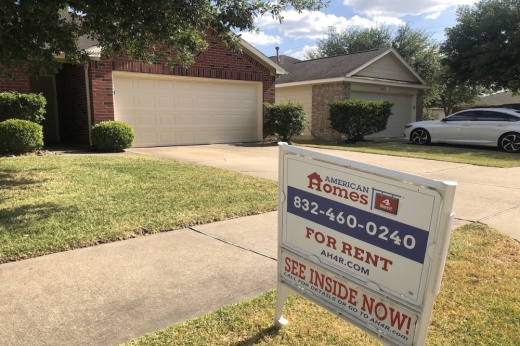The Houston Association of Realtors reported June 15 the number of leased single-family home rentals increased 24.8% from May 2021 to May 2022. While rising mortgages and low inventory are contributing to the trend, experts said potential homebuyers are also facing competition from real estate investment firms—or institutional investors—buying properties to sell or lease.
“These are not mom and pop buyers. They look to buy properties and communities on a large scale and make profit from them,” said Nadia Evangelou, the director of forecasting at the National Association of Realtors.
Texas leads the nation in institutional buying, with 28% of single-family homes purchased by institutional investors in 2021—more than double the national average of 13%, according to a May study from the NAR. Locally, NAR data showed 38% of single-family properties purchased in Harris County in 2021 were bought by institutional investors. Property data from the Harris County Appraisal District shows nearly 7,000 homes in Harris County as of June are owned by five NRHC members and their subsidiaries, listed in order of total number of homes owned in the county: American Homes 4 Rent; FirstKey Homes, whose parent company is Cerberus Capital Management; Progress Residential, whose parent company is Pretium Partners; Invitation Homes, founded by the Blackstone Group; and Tricon Residential. David Howard, executive director of the National Rental Home Council—the nonprofit trade association that represents the single-family rental home industry—said the term “institutional investors” is a catch-all for companies large and small as well as individuals. Citing NRHC member-provided data, Howard said that out of 23 million single-family rental homes in the U.S., only about 300,000, or 1.3%, are owned by large companies.
A May report noted that among the NRHC’s nearly 80 member companies, including “mom and pop” landlords, leadership positions have been “almost exclusively” held by four companies since its founding in 2014: Invitation Homes; Progress Residential; American Homes 4 Rent; and Tricon Residential. In 2020, the CEO of FirstKey Homes joined the NRHC board and is currently the organization’s chair. The report was created jointly by the Action Center on Race and the Economy, a nonprofit hub for organizations focused on racial justice and Wall Street accountability; Private Equity Stakeholder Project, a nonprofit organization that tracks the impacts of private equity; and the Center for Popular Democracy, a nonprofit organization involved in voter mobilization and progressive policy development.
None of the homes owned by institutional investors are located within Loop 610. Five ZIP codes housed between 5%-10% of the investor purchases, specifically in Katy, Spring, Atascocita, Aldine and Humble. Together, homes in these ZIP codes account for more than 35% of the five investment firms’ combined portfolios. In Montgomery County, NAR data showed 29% of single-family properties bought in 2021 were purchased by institutional investors. Data from the Montgomery Central Appraisal District shows nearly 1,300 homes in the county as of June are owned by the same five NRHC members and their subsidiaries.
Institutional investors accounted for 30%, 29% and 23% of all single-family purchases in Galveston, Fort Bend and Brazoria counties, respectively, in 2021.
Invitation Homes and American Homes 4 Rent did not respond to a request for comment, and FirstKey Homes referred Community Impact Newspaper to the NRHC for comment. Impacts on affordable housing
According to Howard, these companies aim to provide access to quality, affordably-priced housing for those who cannot afford to—or prefer not to—purchase a home outright.
“Our intention is not to contribute to any sort of long-term rentership surge in the country,” he said. “To the extent we can assist in that effort to put them on a path toward homeownership, we want to do that as well.”
Investor purchases cause first-time, low-income buyers to face steeper competition for home purchases, as firms tend to target the same properties they would buy, are willing to pay cash and can offer services the average homebuyer cannot, Evangelou said.
Congress members and expert witnesses spoke about purchases by institutional investors in a June 28 virtual hearing of the U.S. House Committee on Financial Services. U.S. Rep. Al Green, D-Houston, opened with a similar sentiment to Evangelou.
“These corporate buyers have tended to target lower-priced starter homes requiring limited renovation ... and tend to be located in communities with significantly more families of color than the national average,” Green said. “This predatory purchasing contributes to our nation’s shortage of affordable housing and exacerbates the racial wealth gap.”
Referencing the ACRE report, Jim Baker, executive director of the Private Equity Stakeholder Project, testified that firms have acquired growing portions of housing since the global financial crisis of 2008, driving up home prices and rent.
“The impact has been sharpest in the single-family rental home industry, which was created by private equity firms,” Baker said. “Just over a decade ago, no single landlord owned more than a thousand homes. Now, the top five—Invitation Homes, Pretium Partners, American Homes 4 Rent, Amherst Holdings and Cerberus Capital—together own or operate almost 300,000.”
Shad Bogany, a Texas Realtor, testified that investors are targeting minority communities and driving up prices for residents, making the dream of homeownership in Houston unachievable.
“The risk today, should investors liquidate their massive real estate holdings, will be a decrease in property value, causing subdivisions to decline, an increasing community in crime ... [and] developing new ghettos creating for rent-only subdivisions,” he said.
Bogany said historically, minority communities are undervalued and have lower-priced homes. The NAR study found that in areas like Houston with more investors than the national average, there are twice as many Black households as in the areas with a lower share of investors. In areas where the share of investors is higher than 30%, the share of Black households is 16% on average.
In the Katy ZIP code 77449—where 10% of all institutionally owned properties in Harris County are located—22.22% of the population is Black, compared to Harris County’s 19.15% Black population, according to the Houston Health Department’s 2022 Houston State of Health data. By ethnicity, 55.23% of the 77449 population is Hispanic or Latino, compared to 45.12% countywide.
Within the five Harris County ZIP codes with the largest institutional investor presence, 26.45% of the population is Black—7.3 percentage points higher than the county level. However, 43.29% of the population in those ZIP codes is Hispanic, slightly lower than the county level.
Rise in communities for rent
Firms that have bought properties have also been investing into developing entire build-to-rent communities due to inventory shortages. Howard cited data from the Single-Family Rental Market Index that showed build-to-rent homes made up 26% of NRHC company portfolios in the fourth quarter of 2021, up from 3% in the third quarter of 2019.
“People are familiar with the fact that there’s a supply crisis when it comes to purchasing a home. But I think people are less familiar with the fact that there’s just as severe a supply crisis in the rental housing market.” Howard said.
Charlie Kriegel, CEO of the Houston-based property advisor firm Winhill Advisors-Kirby, said his clients see build-to-rent as a “windfall” for return on investment.
“[Build-to-rent] allows investors to control cost, absorption rate, so it’s going to be the fastest growing segment for the next five years,” he said.
HAR data released June 15 showed new single-family rental listings increased 28.6% from May 2021 to May 2022. Evangelou said institutional investors focusing on rental properties are contributing to surging rentals.
“They create more rental housing, so even if rents rise, there is more supply,” Evangelou said. “With rising mortgage rates, it gives more options for people.”
A 2022 study conducted by researchers at the University of California at Berkeley found American Homes 4 Rent and Tricon Residential had invested millions of dollars nationally as of the fourth quarter of 2021 in developing homes specifically for rent.
Kriegel, whose clients include Tricon Residential, said build-to-rent communities prioritize favorable tax rates, relaxed homeowner association requirements and good school districts when targeting areas to develop.
“You see a little bit of pushback from established communities where these build-to-rent communities are moving into, and then you’re having developers having to accommodate these types of investors [through relaxed HOA requirements],” Kriegel said.
Similarly, Houston’s flood risks did not appear to significantly affect purchases in the area, Evangelou said. HCAD data did show investment firms owned homes in communities that flooded during Hurricane Harvey in August 2017, such as Norchester, Enchanted Valley and Lakewood Forest along Cypress Creek.
Evangelou said a fast-growing household formation, large millennial and minority renter populations, and still-affordable housing contributed to the Greater Houston area’s status as a target for investors.
“To put it simply, Texas fits all the desired criteria,” she said. “And Houston attracts many investors.”
Long-term impacts
Kriegel said although investment firms are pivoting toward build-to-rent communities, institutional purchases of existing homes will “never go away.” NAR data showed the percentage of homes purchased nationally by investors generally declined from a peak of 15.7% in 2014 to 11.8% in 2020, before rising to 13.1% in 2021. HAR Chair Jennifer Wauhob said the HAR is beginning to upscale its effort to track institutional buying and build-to-rent options. She said the organization is looking at homeownership levels and home values, especially as increased prices affect appraisals and property taxes.
Stephen Sherman, a researcher with the think tank Kinder Institute for Urban Research at Rice University, said that generally speaking, local governments in Texas have the power to regulate both build-to-rent and institutional buying by enacting rent controls—but pressure from local developers and a reluctance to act on a state level means municipalities do not directly tackle institutional investors.
“The ways that you regulate this involve making owning rental properties for profit less profitable,” Sherman said. “Cities such as Houston, Austin and Dallas may try something, but the real estate industry is part of the local governing coalition, and the state government can preempt any rent control law.”
However, Kriegel suggested developers will be able to find “loopholes” in lot sizes, such as by relocating developments to jurisdictions with less restrictive rules.
“You’re dealing with corporate America; they’re going to find ways to be able to develop and build stuff,” Kriegel said. “There needs to be some common ground between city officials and investors to make sure that what they’re building matches the absorption rate and what the market will demand.”
The city of Conroe voted May 26 to increase its minimum lot width size for a subdivision from 40 feet in width to 50 feet. Although the city’s vote was related to a separate ordinance, Conroe Realtor Abbie Holland said larger lots could lead to larger price points—which are less favorable for developers aiming for affordable housing—which in turn could hold both cities and developers “more accountable” for how they structure developments.
“It’s hard; you want growth, you want development and you want a good price for the city of Conroe, but it’s also the city’s responsibility to be attractive, to bring higher paying jobs, so people can afford to live here,” Holland said.
Kriegel suggested trends in institutional investment into single-family properties could change the dynamic of homeownership for both individual buyers and real estate agents across the country. National trends could see at least 40% of single-family homes owned by firms by 2030, which would change the homebuying dynamic, according to a February report from the real estate industry publication PereNews, using data from investment management firm Metlife Investment Management.
“The writing’s on the wall. This is something that’s going to continue; [investors] won’t see a return on their money in any other investment besides real estate,” Kriegel said. “[Institutional investors] are going to dictate the terms, the contract, the price point for everyone [buying] under $400,000—so, a normal American.”






